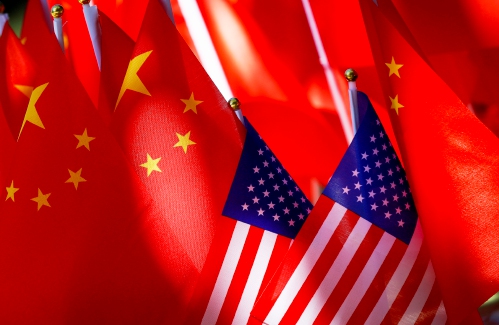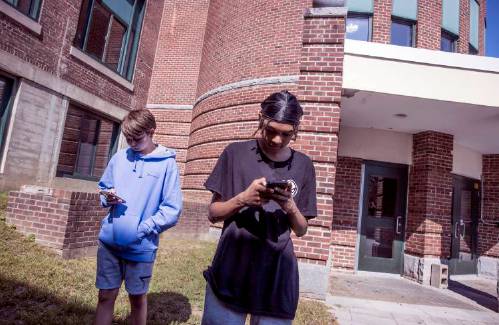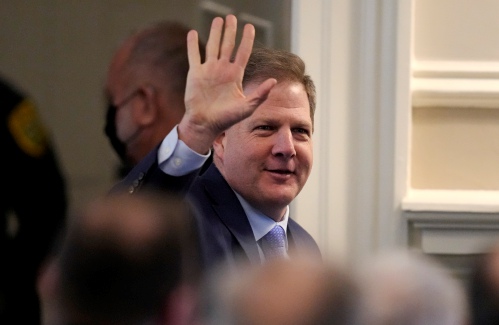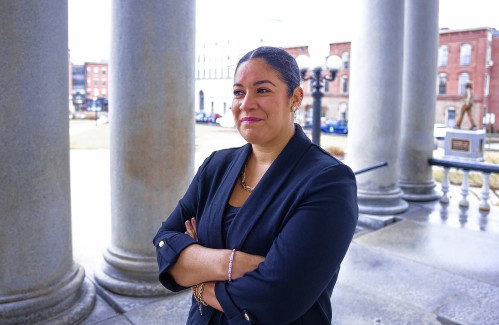
Mullet madness: Young man who died in motorcycle accident remembered at local fundraiser
As the third contestant walked onstage at Concord’s first-ever Mullet Extravaganza, Eric Daniels had a tear in his eye. He was thinking about his grandson.

‘A celebration of summer’: Wine on Main hosts outdoor party
Bicentennial Square came alive on Monday afternoon with Wine on Main’s third annual Day of Celebration ahead of The Dave Matthews Band’s performance in Gilford.
Most Read
 Sudden pile of trash near Exit 13 on Manchester Street in Concord considered ‘illegal dumping’
Sudden pile of trash near Exit 13 on Manchester Street in Concord considered ‘illegal dumping’
 With Steeplegate still held up in court, city privately debates public investment
With Steeplegate still held up in court, city privately debates public investment
 Merrimack Valley schools to consider eliminating most Penacook bus routes
Merrimack Valley schools to consider eliminating most Penacook bus routes
 Blueberries, honey, flowers and more: Dunbarton gets a new farmers’ market
Blueberries, honey, flowers and more: Dunbarton gets a new farmers’ market
 OSHA investigates Pittsfield partial building collapse
OSHA investigates Pittsfield partial building collapse
 Traffic declined at Manchester Airport last year, making it the only major airport in New England that failed to grow
Traffic declined at Manchester Airport last year, making it the only major airport in New England that failed to grow
Editors Picks
 A Webster property was sold for unpaid taxes in 2021. Now, the former owner wants his money back
A Webster property was sold for unpaid taxes in 2021. Now, the former owner wants his money back
 Report to Readers: Your support helps us produce impactful reporting
Report to Readers: Your support helps us produce impactful reporting
 City prepares to clear, clean longstanding encampments in Healy Park
City prepares to clear, clean longstanding encampments in Healy Park
 Concord area population growth in line with state as a whole from 2020 to 2024
Concord area population growth in line with state as a whole from 2020 to 2024
Sports

Athlete of the Week: Michael Heine, Merrimack Valley High School
Michael Heine was a standout football and lacrosse player for Merrimack Valley High School, with his biggest impact coming on the gridiron as a tight end and defensive end.
Opinion

Opinion: Trumpism in a dying democracy
 Opinion: What Coolidge’s century-old decision can teach us today
Opinion: What Coolidge’s century-old decision can teach us today
 Opinion: The art of diplomacy
Opinion: The art of diplomacy
 Opinion: After Roe: Three years of resistance, care and community
Opinion: After Roe: Three years of resistance, care and community
 Opinion: Iran and Gaza: A U.S. foreign policy of barbarism
Opinion: Iran and Gaza: A U.S. foreign policy of barbarism

Your Daily Puzzles

An approachable redesign to a classic. Explore our "hints."

A quick daily flip. Finally, someone cracked the code on digital jigsaw puzzles.

Chess but with chaos: Every day is a unique, wacky board.

Word search but as a strategy game. Clearing the board feels really good.

Align the letters in just the right way to spell a word. And then more words.
Politics

New Hampshire school phone ban could be among strictest in the country
When Gov. Kelly Ayotte called on the state legislature to pass a school phone ban in January, the pivotal question wasn’t whether the widely popular policy would pass but how far it would go.
 Sununu decides he won’t run for Senate despite praise from Trump
Sununu decides he won’t run for Senate despite praise from Trump
Arts & Life

League of NH Craftsmen 92nd annual fair coming to Newbury
The League of New Hampshire Craftsmen will hold its 92nd annual Craftsmen’s Fair from Saturday, August 2 to Sunday, August 10. The fair will take place at Mount Sunapee in Newbury.
 Community Players of Concord celebrate 97th season, prepare for 98th
Community Players of Concord celebrate 97th season, prepare for 98th
 Henniker Blues, Brews & BBQ Fest returns for fourth year
Henniker Blues, Brews & BBQ Fest returns for fourth year
 Artist Spotlight: Holly Emrick
Artist Spotlight: Holly Emrick
 Concert on the lawn coming to Pierce Manse
Concert on the lawn coming to Pierce Manse
Obituaries
 Curtis Avery
Curtis Avery
Concord, NH - Curtis "Curt" Avery passed away tragically in a motor vehicle accident on July 13, 2025. Born on February 5, 1956, to Antoinette E. Griffin and Robert S. Avery, Curt, or "Curly" as many knew him, grew up in Concord and spe... remainder of obit for Curtis Avery
 Laurence Wheeler Lougee Jr.
Laurence Wheeler Lougee Jr.
Durham, NH - Laurence Wheeler Lougee, Jr., age 76, formerly of New Hampton NH and St. Helena Island, SC, died peacefully at RiverWoods Durham (NH) on Wednesday, June 17, 2025, from complications of Progressive Supranuclear Palsy (PSP). ... remainder of obit for Laurence Wheeler Lougee Jr.
 Earl Plant
Earl Plant
Boscawen, NH - Earl Leander Plant, 95, passed away June 18, 2025. Earl was born in Boston, MA to Harry and Marion (Webb) Plant on November 14, 1929. While living in Belchertown, MA he graduated from a local trade school. Earl marri... remainder of obit for Earl Plant
 Thomas G. Ferris
Thomas G. Ferris
Concord, NH - Thomas George Ferris, 70, of Concord, NH, known to everyone who knew and loved him as Tommy, passed away unexpectedly on July 23, 2025. Thomas was born in Stoneham, MA, on May 31, 1955, to William and Andrea (Richardso... remainder of obit for Thomas G. Ferris


 Opinion: On climate, stupid is in charge
Opinion: On climate, stupid is in charge
 ‘Entire paradigm has to shift’: Majority of parents express support for phone ban, but predict rocky rollout
‘Entire paradigm has to shift’: Majority of parents express support for phone ban, but predict rocky rollout
 John Herbert, longtime Salisbury moderator and selectman, dies at 82
John Herbert, longtime Salisbury moderator and selectman, dies at 82
 Motorcyclist being evaluated at Concord Hospital after crash with mail truck
Motorcyclist being evaluated at Concord Hospital after crash with mail truck
 Memorial Field Committee inches toward final conceptual plan and will receive more accurate cost estimates on Aug. 12th
Memorial Field Committee inches toward final conceptual plan and will receive more accurate cost estimates on Aug. 12th

 Concord National LL Softball to play in second game of NE Regional on Tuesday after loss to Guilford, Connecticut
Concord National LL Softball to play in second game of NE Regional on Tuesday after loss to Guilford, Connecticut Bow Brook Tennis Club hosts men’s A and B tournaments
Bow Brook Tennis Club hosts men’s A and B tournaments Concord National LL Softball wins State Championship and moves on to Little League Regional Tournament
Concord National LL Softball wins State Championship and moves on to Little League Regional Tournament Josiah Hakala of Beaver Meadow wins State Amateur golf championship
Josiah Hakala of Beaver Meadow wins State Amateur golf championship Concord became a Housing Champion. Now, state lawmakers could eliminate the funding.
Concord became a Housing Champion. Now, state lawmakers could eliminate the funding. ‘A wild accusation’: House votes to nix Child Advocate after Rep. suggests legislative interference
‘A wild accusation’: House votes to nix Child Advocate after Rep. suggests legislative interference  Town elections offer preview of citizenship voting rules being considered nationwide
Town elections offer preview of citizenship voting rules being considered nationwide
